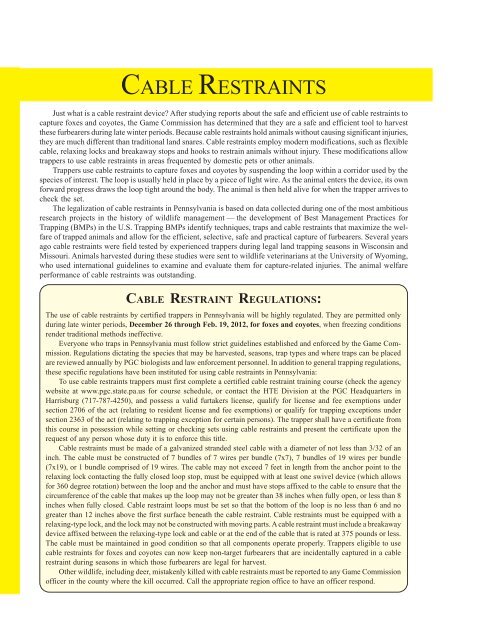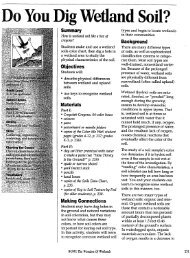Digest of Hunting and Trapping Regulation - Pennsylvania Envirothon
Digest of Hunting and Trapping Regulation - Pennsylvania Envirothon
Digest of Hunting and Trapping Regulation - Pennsylvania Envirothon
Create successful ePaper yourself
Turn your PDF publications into a flip-book with our unique Google optimized e-Paper software.
CABLE RESTRAINTS<br />
Just what is a cable restraint device? After studying reports about the safe <strong>and</strong> efficient use <strong>of</strong> cable restraints to<br />
capture foxes <strong>and</strong> coyotes, the Game Commission has determined that they are a safe <strong>and</strong> efficient tool to harvest<br />
these furbearers during late winter periods. Because cable restraints hold animals without causing significant injuries,<br />
they are much different than traditional l<strong>and</strong> snares. Cable restraints employ modern modifications, such as flexible<br />
cable, relaxing locks <strong>and</strong> breakaway stops <strong>and</strong> hooks to restrain animals without injury. These modifications allow<br />
trappers to use cable restraints in areas frequented by domestic pets or other animals.<br />
Trappers use cable restraints to capture foxes <strong>and</strong> coyotes by suspending the loop within a corridor used by the<br />
species <strong>of</strong> interest. The loop is usually held in place by a piece <strong>of</strong> light wire. As the animal enters the device, its own<br />
forward progress draws the loop tight around the body. The animal is then held alive for when the trapper arrives to<br />
check the set.<br />
The legalization <strong>of</strong> cable restraints in <strong>Pennsylvania</strong> is based on data collected during one <strong>of</strong> the most ambitious<br />
research projects in the history <strong>of</strong> wildlife management — the development <strong>of</strong> Best Management Practices for<br />
<strong>Trapping</strong> (BMPs) in the U.S. <strong>Trapping</strong> BMPs identify techniques, traps <strong>and</strong> cable restraints that maximize the welfare<br />
<strong>of</strong> trapped animals <strong>and</strong> allow for the efficient, selective, safe <strong>and</strong> practical capture <strong>of</strong> furbearers. Several years<br />
ago cable restraints were field tested by experienced trappers during legal l<strong>and</strong> trapping seasons in Wisconsin <strong>and</strong><br />
Missouri. Animals harvested during these studies were sent to wildlife veterinarians at the University <strong>of</strong> Wyoming,<br />
who used international guidelines to examine <strong>and</strong> evaluate them for capture-related injuries. The animal welfare<br />
performance <strong>of</strong> cable restraints was outst<strong>and</strong>ing.<br />
CABLE RESTRAINT REGULATIONS:<br />
The use <strong>of</strong> cable restraints by certified trappers in <strong>Pennsylvania</strong> will be highly regulated. They are permitted only<br />
during late winter periods, December 26 through Feb. 19, 2012, for foxes <strong>and</strong> coyotes, when freezing conditions<br />
render traditional methods ineffective.<br />
Everyone who traps in <strong>Pennsylvania</strong> must follow strict guidelines established <strong>and</strong> enforced by the Game Commission.<br />
<strong>Regulation</strong>s dictating the species that may be harvested, seasons, trap types <strong>and</strong> where traps can be placed<br />
are reviewed annually by PGC biologists <strong>and</strong> law enforcement personnel. In addition to general trapping regulations,<br />
these specific regulations have been instituted for using cable restraints in <strong>Pennsylvania</strong>:<br />
To use cable restraints trappers must first complete a certified cable restraint training course (check the agency<br />
website at www.pgc.state.pa.us for course schedule, or contact the HTE Division at the PGC Headquarters in<br />
Harrisburg (717-787-4250), <strong>and</strong> possess a valid furtakers license, qualify for license <strong>and</strong> fee exemptions under<br />
section 2706 <strong>of</strong> the act (relating to resident license <strong>and</strong> fee exemptions) or qualify for trapping exceptions under<br />
section 2363 <strong>of</strong> the act (relating to trapping exception for certain persons). The trapper shall have a certificate from<br />
this course in possession while setting or checking sets using cable restraints <strong>and</strong> present the certificate upon the<br />
request <strong>of</strong> any person whose duty it is to enforce this title.<br />
Cable restraints must be made <strong>of</strong> a galvanized str<strong>and</strong>ed steel cable with a diameter <strong>of</strong> not less than 3/32 <strong>of</strong> an<br />
inch. The cable must be constructed <strong>of</strong> 7 bundles <strong>of</strong> 7 wires per bundle (7x7), 7 bundles <strong>of</strong> 19 wires per bundle<br />
(7x19), or 1 bundle comprised <strong>of</strong> 19 wires. The cable may not exceed 7 feet in length from the anchor point to the<br />
relaxing lock contacting the fully closed loop stop, must be equipped with at least one swivel device (which allows<br />
for 360 degree rotation) between the loop <strong>and</strong> the anchor <strong>and</strong> must have stops affixed to the cable to ensure that the<br />
circumference <strong>of</strong> the cable that makes up the loop may not be greater than 38 inches when fully open, or less than 8<br />
inches when fully closed. Cable restraint loops must be set so that the bottom <strong>of</strong> the loop is no less than 6 <strong>and</strong> no<br />
greater than 12 inches above the first surface beneath the cable restraint. Cable restraints must be equipped with a<br />
relaxing-type lock, <strong>and</strong> the lock may not be constructed with moving parts. A cable restraint must include a breakaway<br />
device affixed between the relaxing-type lock <strong>and</strong> cable or at the end <strong>of</strong> the cable that is rated at 375 pounds or less.<br />
The cable must be maintained in good condition so that all components operate properly. Trappers eligible to use<br />
cable restraints for foxes <strong>and</strong> coyotes can now keep non-target furbearers that are incidentally captured in a cable<br />
restraint during seasons in which those furbearers are legal for harvest.<br />
Other wildlife, including deer, mistakenly killed with cable restraints must be reported to any Game Commission<br />
<strong>of</strong>ficer in the county where the kill occurred. Call the appropriate region <strong>of</strong>fice to have an <strong>of</strong>ficer respond.



